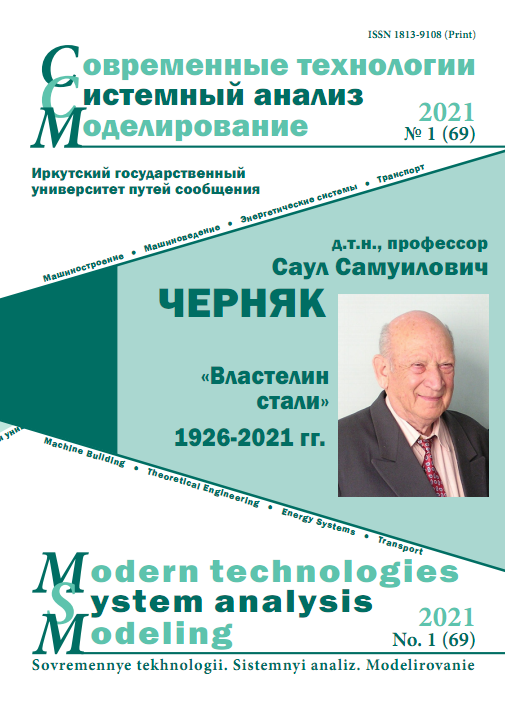Энергетический критерий для оценки запаса устойчивости колеса от вкатывания гребня на головку рельса при движении колесной пары по прямому участку пути
Ключевые слова:
безопасность движения, безопасная скорость, вагон, колесная пара, колесо, сход с рельсов, катывание колеса на головку рельса, энергетический методАннотация
При извилистом движении создаются боковые силы нажатия колес на рельсы, что может привести к вкатыванию гребня колеса на головку рельса и к последующему сходу. Сход подвижного состава с рельсов представляют серьезную угрозу безопасности движения. Действующими нормами для расчета и проектирования вагонов железных дорог колеи 1520 мм предусмотрена проверка устойчивости колеса от вкатывания на головку рельса. В качестве критерия принято минимальное значение коэффициента запаса устойчивости колеса против схода с рельса. Коэффициент устойчивости определяется исходя из условия возвращения вкатившегося на головку рельса колеса в исходное положение под действием вертикальной силы, создаваемой весом вагона. В современной механике большинство методов расчета основано на энергетических принципах, что составляет так называемую «аналитическую механику», альтернативную «векторной (ньютоновской) механике». Предложен метод оценки устойчивости колеса исходя из условия недопущения вкатывания гребня колеса на головку рельса путем сравнения кинетической энергии извилистого движения колесной пары с работой вертикальной и горизонтальной сил, действующих на колесную пару. Условие устойчивости колеса определяется из принципа недопущения вкатывания гребня колеса на головку рельса. Выполнены расчеты вариантов движения вагона при различных скоростях на основе нормативной и предложенной методик. Произведено сравнение критической (допускаемой) скорости движения по названным методикам. Сравнительный анализ показал, что при оценке устойчивости по энергетическому критерию, допустимая скорость движения вагона выше, чем при силовом методе. Это может позволить увеличить расчетный скоростной допуск проектируемого вагона при дальнейшем детальном анализе и оценке всех динамических факторов вагона.
Библиографические ссылки
Клименко И.В. Развитие теоретических основ и методов оценки и повышения безопасности движения подвижного состава железных дорог : дис. … д-ра техн. наук. Днепропетровск, 2015. 284 с.
Evans A.W. Fatal train accidents on Europe’s railways: 1980–2009. Accident Analysis and Prevention // National Library of Medicine. 2011. 43. P. 391–401. DOI: 10.1016/j.aap.2010.09.009.
Kumar K.A. Indian Railways: Recent Trends in Control Accidents and Safety Measures for Passengers // East Asian Journal of Business Economics. 2014. Vol. 2, № 4. Р. 48–55.
Арутюнян А.Р., Арутюнян Р.А. Критерий усталости, основанный на результатах исследований по скрытой энергии деформации // Вестн. Санкт-Петербур. ун-та. Сер.: Математика. Механика. Астрономия. 2010. № 3. С. 80–88.
Боронахин А.М., Гупалов В.И., Филипеня Н.С. Инерциальные методы и средства диагностики рельсового пути // Гироскопия и навигация. 2006. № 4. С. 102.
Влахова А.В. Моделирование движения железнодорожного экипажа при вкатывании гребня колеса на рельс с использованием подхода Дирака // Вестн. Моск. ун-та. Сер.: Математика. Механика. 2014. № 3. С. 68–72.
Ахмадеева А.А., Гозбенко В.Е. Рациональное задание числа степеней свободы динамической модели грузового вагона // Системы. Методы. Технологии. 2011. № 4 (12). С. 25–28.
Курбацкий Е.Н., Нгуен Ч.Т. Определение критических скоростей и критических сил при движении постоянной силы по балкам на упругом основании // Изв. высш. учеб. заведений. Строительство. 2014. № 5. С. 109–117.
Мугинштейн Л.А., Ромен Ю.С. Влияние продольных сил на опасность сходов порожних вагонов в поездах // Вестник ВНИИЖТ. 2011. № 3. С. 3–6.
Reducing the threat of in-transit derailments involving dangerous goods through effective placement along the train consist / M. Bagheri, F. Saccomanno, Sh. Chenouri et al. // Accident Analysis & Prevention. 2011. Vol. 43, is. 3. Р. 613–620. DOI 10.1016/j.aap.2010.09.008.
Eom B., Lee H.S. Assessment of running safety of railway vehicles using multibody dynamics // International Journal of Precision Engineering and Manufacturing volume. 2010. 11, 315-320. DOI: 10.1007/s12541-010-0036-x.
Gilchrist A.O., Brickle B.V. A re-examination of the proneness to derailment of a railway wheelset // Journal of Mechanical Engineering Science. 1976. Vol. 18, № 3. Р. 131–141.
Ham Y., Lee D., Kwon S. et al. Continuous measurement of interaction forces between wheel and rail // International Journal of Precision Engineering and Manufacturing volume. 2009. Vol. 10. Р. 35–39. DOI: 10.1007/s12541-009-0006-3.
Theoretical cross-wind speed against rail vehicle derailment considering the cross-running wind of trains and the dynamic wheel-rail effects / M.S. Kim, G.Y. Kim, H.T. Kim et al. // Journal of Mechanical Science and Technology. 2016. Т. 30, is. 8. Р. 3487–3498.
Koo J. A new derailment coefficient considering dynamic and geometrical effects of a single wheelset // Journal of Mechanical Science and Technology. 2014. Т. 28, is. 9. Р. 3483–3498.
Determing the causes of rolling stock derailment from the track using modern research methods / A. Kuzyshin, A. Batig, J. Sobolevska et al. // MATEC Web of Conferences. 2009. 294, 03004. DOI 10.1051/matecconf/201929403004.
Liu X., Saat M.R., Barkan Ch. Freight-train derailment rates for railroad safety and risk analysis // Accident Analysis & Prevention. 2017. Vol. 98. Р. 1-9. DOI 10.1016/j.aap.2016.09.012.
Nadal M. J. Locomotive á Vapeur. Paris : Collection encyclopédie scintifique ; bibliotéque de mécanique appliquée et génie, 1908. Vol. 186.
Weinstock H. Wheel Climb Derailment Criteria for Evaluation of Rail Vehicle Safety // ASME Winter Annual Meeting. 1984. paper no. 84-WA/RT-1. Р. 1–7.
Нормы для расчета и проектирования вагонов железных дорог МПС колеи 1520 мм (несамоходных). М. : ГосНИИВ-ВНИИЖТ, 1996. 317 с.
Вершинский С.В., Данилов В.Н., Хусидов В. Д. Динамика вагона. М. : АСПОЛ, 1991. 360 c.
Смольянинов А.В., Якупов А.Р. Сравнительный анализ методик расчета устойчивости колесной пары от схода с рельсов // Транспорт Урала. 2017. № 1. С. 48–54. DOI 10.20291/1815-9400-2016-2-48-54.
Котуранов В.Н., Козлов М.П. Технологическая последовательность экспертных оценок рабочих качеств универсального грузового вагона (на примере цистерны 15-1443) : учеб. пособие. М. : МИИТ, 2013. 147 с.


